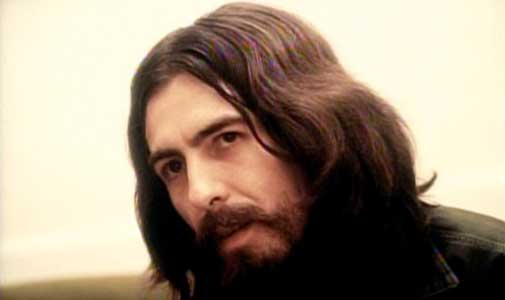
When George Harrison passed away in 2001, Brian Wilson, founder of The Beach Boys wrote: "I am horribly saddened by the death of George Harrison. While we were not personal friends, I think that just like everybody in the world, I have always considered all the Beatles to be my friends."
And that's the thing about Harrison and the group: they were so much a part of our world for so long, they were like family. George Harrison: Living in the Material World, Martin Scorsese's new four-hour HBO biography of Harrison, takes an in-depth look at our friend who gave us all the beautiful music a soul could muster, and all the aloofness and coldness only fame could create...
There are so many documentaries, books and plays about The Beatles, especially John Lennon, that the story is almost canon by now. You wonder what new can be brought to the table.
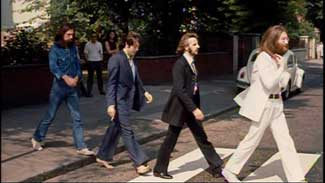 Although we well know the basic elements of the Harrison story, and they're all here, the brilliance of Scorsese's documentary (shown in two parts, Wednesday and Thursday nights at 9 p.m. ET) is that he takes these familiar bricks -- along with rare photos, postcards, home films made by Harrison himself, and new interviews with Olivia and Dhani Harrison, Eric Clapton, Ringo Starr and Tom Petty -- and makes something new, something we didn't know. (At right, for example, a delightful alternate photo of The Beatles in the zebra crosswalk for the Abbey Road album cover.)
Although we well know the basic elements of the Harrison story, and they're all here, the brilliance of Scorsese's documentary (shown in two parts, Wednesday and Thursday nights at 9 p.m. ET) is that he takes these familiar bricks -- along with rare photos, postcards, home films made by Harrison himself, and new interviews with Olivia and Dhani Harrison, Eric Clapton, Ringo Starr and Tom Petty -- and makes something new, something we didn't know. (At right, for example, a delightful alternate photo of The Beatles in the zebra crosswalk for the Abbey Road album cover.)
The result is an engrossing portrait, and a definitive new house for the Harrison legacy.
For those born after the Sixties, or too young to remember his solo career, it's also a great opportunity to experience how rock sprang out of post-WWII popular culture, and how it accompanied the tidal changes in society, as traditional family and gender roles fell under their own weight and fragmented into what we have today. Harrison's world view shifted right along with the rest of it.
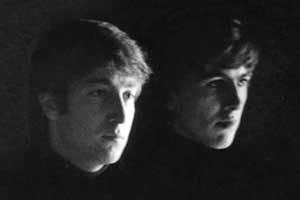
A large part of the intimacy of Scorsese's work is firmly planted in The Beatles' early time in Hamburg, Germany, where they honed their chops and were photographed in evocative black-and-white by Astrid Kirchherr, who became their close friend, along with bassist Klaus Voorman.
You get a very strong, early indication of George's inner character, which later on became deepened by his practice of Indian meditation and chanting. Voorman says, "George was only seventeen years of age. But he was calm, he looked you straight in the face, he was funny, and he was a catalyst in the band... He would bring a certain peace into this setup."
It's even a bigger tip that George was destined for something beyond what he would eventually deride as the dumb trappings of fame. In a clip from their first American tour when he was in in his early twenties, he says, "We do like the fans, and enjoy reading the publicity about us, but, from time to time... you don't actually think, 'That's me in the paper.' It's funny, you just think it's a different person."
From the earliest brushes with the international press and public, he was keenly aware of the difference between what people thought he was -- presumed he was -- and the person in the world he actually was.
There is riveting old footage of Harrison and The Beatles playing small clubs and function rooms, just like any other struggling garage band. It's all the more striking a backdrop, since it both prefaces and contrasts sharply with Harrison's emergence later in The Beatles, and afterward, as a steadfast songwriter and a relentless perfectionist and craftsman.
For those of us who weren't the Alpha Male or Queen Bee of our particular social circles, Harrison seemed more like he was one of us: a wallflower in the back, waiting for the huckstering and bluster in front of him to blow off and give him his turn to show his stuff.
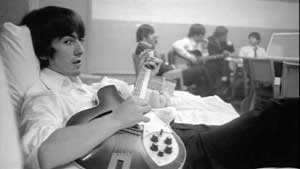
It just so happened he was in a group with two of the world's greatest rock writers. The Beatles' producer, George Martin, says he was often the odd man out of the McCartney-Lennon collaboration. "George was the solo guy," Martin says. "He had no one to work with."
Perhaps most interesting in Living In The Material World is the detail Scorsese provides about Harrison's interest in Hindu classical music and philosophy, particularly as a student of the sitar master Ravi Shankar. Scorsese takes time and effort to explore the nature and physicality of sound, its connection to the Hindu practice of chanting, and the connection of them both to the ability to experience spirituality and the nature of the cosmos.
Says Shankar, "Sound is God. Music has this power... Our music has been handed down from person to person. It is not written down. Meaning of life, philosophy... everything is passed along with the music."
We get fun lessons in what it was like for Ringo to concoct drum parts for Harrison's "Here Come The Sun," which use bridges that are in 5/7 time, borrowed from his sitar training -- and how funny and frustrating it was for a western drummer just to get it in.
Time also is spent on Harrison's decision to bring Clapton into the studio with The Beatles to record; his infamous break from them; his growth as a solo songwriter; producing new Apple artists such as Badfinger; and launching Handmade Films, teaming up with the comedy group Monty Python to release The Life of Brian in 1979.
(Incidentally, TVWW has been having a great, great laugh this week, thanks to a sketch from Brian which, depending on your point of view, might be the funniest comedy clip ever. See "Biggus Dickus" here:)
It rounds out a very complex portrait of a guy who loved humor, loved the life of the higher mind, and loved to be around people who were the best at what they did.
Harrison also was someone who truly loved collaboration -- with Bob Dylan, the Traveling Wilburys, director Terry Gilliam -- which explains, perhaps, why he was so frustrated at times with the Beatles. Says the late Neil Aspinall, formerly CEO of The Beatles company Apple Corps, of Harrison's relationship with his fellow bandmates:
"It was difficult to get a song onto an album. [The song] 'All Things Must Pass' didn't make it onto Let It Be, and didn't make it onto Abbey Road... He was stockpiling stuff. Stuff was building up."
According to Phil Spector, Harrison's producer on his debut solo album, All Things Must Pass, he had a backlog of hundreds of songs written, but never used by The Beatles.
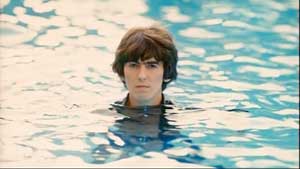
But beyond the streaking, galactic light and the family spats of The Beatles, the best parts of HBO's Living In The Material World are the intimate moments of impromptu comments caught on home video; postcards being voiced-over by Dhani (who is the haunting likeness of his father); and personal remembrances by McCartney and Starr.
And after all, Harrison's life was about the music. There are wonderful moments that play clips of delicate, rich and complexly layered compositions of "Wah Wah," "Awaiting On You All," and "All Things Must Pass," among many others.
There also are clean, rehearsal versions of songs here, such as "Don't Bother Me," without voice and mixing effects. They are amazingly spare and beautiful -- and extremely evocative of Harrison's raw talent.
Olivia Harrison also recounts the attempt on George's life at his home in Friar Park in 1999 -- a frightening and surreal experience where the very spiritual couple found themselves fighting fiercely for their lives against a psychotic man with a knife. George was stabbed several times, and suffered a partially collapsed lung.
Olivia's father, a baseball fan, always taught her to swing through the ball, and the sobering picture of their attacker, in a plainly lit mug photo with stitches elaborately laced across his entire face, shows all too clearly who got the better of that encounter.
Spiritual or not, she's got a wicked game swing.
Harrison's trademark cynical wit, says Python's Eric Idle, was ever at the ready, even as he was being carried out of the house on a stretcher. According to Idle, Harrison lifted his head to ask two new employees who had just started at the house that week, "So, what do you think of the job so far?"
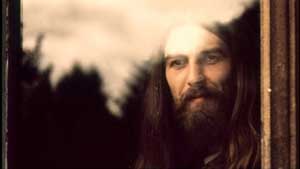
Living In The Material World finishes with perhaps one of George's most haunting, most original works from his work with the Beatles: the so-called "White Album," where he sings his song "Long, Long, Long."
The song instrumentation -- a warbling mellotron and acoustic guitar -- disintegrates into a few simple phrases at the end, like a child's toy clattering to the floor, and it's just his acoustic guitar and one drum riff left.
Not a guitar gently weeping -- but flickering away, and losing steam with a unbothered, discordant open chord.
Undramatic.
Final.
Well done.